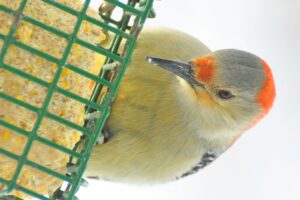Photography courtesy of Lowell Washburn, all rights reserved.
If you’re feeding backyard birds, you’ve probably noticed a significant increase in activity during the past few days. With double digit below zero temps and wind chill values plunging to minus forty, it’s little wonder that our feathered visitors are busily cramming down every bit of food they can find.

Strategically installed feeders save wintering birds time and energy. During periods of extreme weather, such as we’ve endured during the first part of the new year, bird feeders have the potential to increase wildlife survival. Simply put, bird feeders are good for us and they are good for the birds.
Winter bird feeding can be as simple or as complex as an individual cares to make it. Sunflower seeds and cracked corn are basic, high-energy foods that are eagerly utilized by most backyard species. Although both grains can be used in hanging feeders, some birds prefer to feed on the ground. Offering food at both levels will attract the optimum variety of cold weather birdlife. Targeting individual species will also increase variety. Niger seed, for example, will attract the greatest number of finches. Suet cakes or peanut butter will increase the number of nuthatches and woodpeckers you’ll observe.

Providing open water is also one of the most important, though most often overlooked, aspect of winter feeding. Most birds can survive by utilizing snow for water, of course, but melting snow burns excessive amounts of precious calories. Electric bath pans are the most convenient option for providing water. If you don’t have one of these, wintering birds can still benefit if you place a pan of warm tap water near feeders. Pans made of black rubber work better than metal. During most winter days, the open water will last for at least a couple of hours before it starts to skim over.
Winter bird feeding is a pastime that is enjoyed by millions of Americans. Feeding birds is something that makes us feel good and, better yet, makes the birds feel even better.

 Tom Cope
Tom Cope Sue Wilkinson
Sue Wilkinson Susan Judkins Josten
Susan Judkins Josten Rudi Roeslein
Rudi Roeslein Elyssa McFarland
Elyssa McFarland Mark Langgin
Mark Langgin Adam Janke
Adam Janke Joe Henry
Joe Henry Kristin Ashenbrenner
Kristin Ashenbrenner Joe Wilkinson
Joe Wilkinson Dr. Tammy Mildenstein
Dr. Tammy Mildenstein Sean McMahon
Sean McMahon